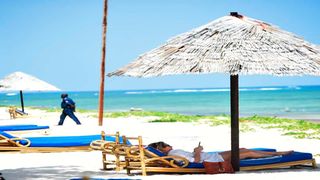
A tourist sunbathes at Diani Reef Resort Beachfront in this photo taken on January 31, 2021.
| Kevin Odit | Nation Media GroupBusiness
Premium
Yatani’s cuts to Tourism budget rattles sector reeling from Covid effects
What you need to know:
- This is bad news for a sector bogged down in the past year by global Covid-19-related lockdowns and movement restrictions.
- The tourism sector has faced several challenges that, Treasury says, were addressed through concerted efforts between different players
The tourism sector is headed for a shock after National Treasury Cabinet Secretary Ukur Yatani indicated he will cut its funding in the new financial year by up to 30 per cent, rattling an area of the economy already suffering from the effects of Covid-19.
In the Budget Estimates for 2021/2022, the sector will see its current allocation of Sh9.4 billion, the largest ever, reduced to Sh6.97 billion, with Treasury chopping nearly all its promotions programme budgets.
This is bad news for a sector bogged down in the past year by global Covid-19-related lockdowns and movement restrictions and security threats, which all resulted in the shuttering of facilities such as hotels and the loss of thousands of jobs.
In the new financial year, the Tourism Promotion and Marketing programme’s current budget of Sh1.8 billion will be reduced to Sh1 billion. And the budget for the niche tourism product development and diversification programme will be cut from Sh2.7 billion to Sh2.14 billion.
The tourism infrastructure development budget has also been cut to Sh2.96 billion, from Sh3.56 billion, while the tourism training and capacity building programme has also seen its budget reduced to Sh451.39 million, from the current Sh677.36 million.
Though the sector is struggling, the ministry’s budgetary absorption rate has been dropping in the past three years even as players call for more aggressive government efforts to salvage it.
The State Department of Tourism’s allocation was Sh3.7 billion, Sh5.2 billion and Sh9.7 billion in the 2017/18, 2018/19 and 2019/20 financial years, respectively.
Faced several challenges
However, the actual expenditure amounted to Sh3 billion, Sh4.3 billion and Sh6.7 billion in those fiscal years, respectively, translating into an absorption rate of 81 percent, 83 percent and 69 per cent, respectively.
“Notable achievements during the period under review include increased earnings from tourism revenue from Sh119.9 billion to Sh163.6 billion, an increase in international tourist arrivals from 1.45 million to 2.04 million and an increase in the number of bed nights’ occupancy by Kenyans from 3.65 million to 4.82 million,” Treasury said.
The improved performance, it says, can be attributed to growth in aviation, investor confidence, withdrawal of travel advisories, visits by foreign dignitaries, and high-profile international conferences.
The tourism sector has faced several challenges that, Treasury says, were addressed through concerted efforts between different players. These challenges included the Covid-19 pandemic and the effects of lockdowns and movement restrictions locally and internationally, security threats, environmental challenges, inadequate infrastructure, insufficient funding, seasonality of tourism.
“Among the measures that were put in place to mitigate the challenges were the allocation of funds to stimulate tourism recovery, operationalization of the Tourism Promotion Fund to supplement funding from the exchequer, development of the Mama Ngina Waterfront as a niche product, collaboration with other partners in areas of insecurity and environmental challenges,” Treasury said.
The Tourism department, it says, will in the next two years work to revive the tourism industry from the effects of the Covid-19 pandemic and increase its contribution to the economy.
“Targeted areas include the completion of the Ronald Ngala Utalii College project, full operationalization of the Tourism Promotion Fund, continued funding of tourism promotion and marketing to increase tourist arrivals and earnings. The Tourism Promotion Fund will invest in strategic areas with the potential of boosting the sector performance over the medium term,” it says.
Ailing tourism sector
In May last year, President Uhuru Kenyatta unveiled a comprehensive package to rescue the ailing tourism sector in the wake of the coronavirus pandemic.
However, most investors are yet to take up the loans, with the players urging the State to help them reduce their operational costs, including electricity and taxes, instead of applying for funds from the kitty.
The State unveiled the credit scheme so hotels could access cheap loans to cushion the industry from the impact of Covid-19.
The Tourism Finance Corporation allocated the Coast region Sh1.8 billion of the Sh3 billion kitty, but only a few hotels have qualified for the soft loans. The facilities will access the loans at an interest rate of five percent.
Borrowers will start repaying the loans after one year and the programme will run for 10 years. The coastal region received a bigger share because it relies heavily on the tourism.
The State department of wildlife has, however, seen its budget increased in the new financial year from the current Sh8.28 billion to Sh9.63 billion.
The biggest winner will be the Wildlife Security, Conservation and Management programme, whose allocation is Sh9.24 billion, up from Sh8.06 billion. The allocation for Wildlife Research and Development has also risen fivefold from Sh30 million to Sh150 million.





